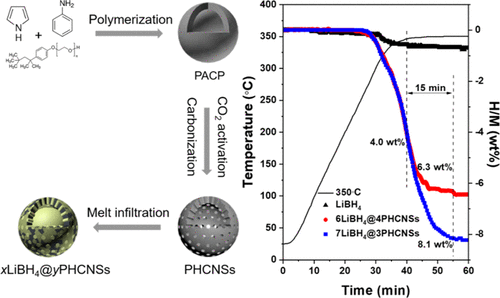当前位置:
X-MOL 学术
›
ACS Appl. Energy Mater.
›
论文详情
Our official English website, www.x-mol.net, welcomes your
feedback! (Note: you will need to create a separate account there.)
LiBH4 Nanoconfined in Porous Hollow Carbon Nanospheres with High Loading, Low Dehydrogenation Temperature, Superior Kinetics, and Favorable Reversibility
ACS Applied Energy Materials ( IF 5.4 ) Pub Date : 2020-03-12 00:00:00 , DOI: 10.1021/acsaem.0c00325 Shun Wang 1 , Mingxia Gao 1 , Kaicheng Xian 1 , Zhenglong Li 1 , Yi Shen 1 , Zhihao Yao 1 , Yongfeng Liu 1 , Hongge Pan 1
ACS Applied Energy Materials ( IF 5.4 ) Pub Date : 2020-03-12 00:00:00 , DOI: 10.1021/acsaem.0c00325 Shun Wang 1 , Mingxia Gao 1 , Kaicheng Xian 1 , Zhenglong Li 1 , Yi Shen 1 , Zhihao Yao 1 , Yongfeng Liu 1 , Hongge Pan 1
Affiliation

|
Lithium borohydride (LiBH4), with a high hydrogen capacity of 18.5 wt %, is an ideal candidate for hydrogen storage; however, it suffers from high thermal stability, low kinetics, and poor reversibility. Nanoconfinement is an effective strategy to tackle these problems, but a main drawback of nanoconfined systems is the low loading fraction of LiBH4, which leads to a low theoretical hydrogen capacity of the systems. It is thus highly desired to design scaffolds with high porosity and a reasonable pore structure for achieving high loading of LiBH4. In this work, porous hollow carbon nanospheres (PHCNSs) with uniform size, high specific surface area, large pore volume, and reasonable pore structure are delicately designed and controllably synthesized as the scaffold for confining LiBH4. The as-prepared PHCNSs can accommodate up to 70 wt % LiBH4, while the system still shows a low dehydrogenation temperature of ca. 200 °C and releases rapidly 8.1 wt % H2 at 350 °C within 25 min. Such a high loading of LiBH4 and high dehydrogenation capacity at a low temperature have never been reported to date based on our knowledge of carbon-based nanoconfined LiBH4 systems. Moreover, the system with 60 wt % LiBH4 shows favorable reversibility and rapid hydrogenation under moderate conditions. The morphology and structure evolutions of the confined systems during cycling are investigated, and the mechanism of the improved hydrogen storage property is proposed. The present work provides further insight into rationally utilizing porous carbon scaffolds with a well-designed structure to improve the hydrogen storage performance of LiBH4.
中文翻译:

LiBH 4纳米受限于多孔中空碳纳米球,具有高负载,低脱氢温度,优异的动力学和良好的可逆性
硼氢化锂(LiBH 4)具有18.5 wt%的高氢容量,是理想的储氢材料;但是,它具有高的热稳定性,低的动力学和可逆性。纳米约束是解决这些问题的有效策略,但是纳米约束系统的主要缺点是LiBH 4的负载率低,这导致系统的理论氢容量低。因此,非常需要设计具有高孔隙率和合理的孔结构的支架以实现高负载的LiBH 4。。在这项工作中,精心设计并控制合成了尺寸均匀,比表面积大,孔体积大,孔结构合理的多孔中空碳纳米球,作为封闭LiBH 4的支架。所制备的PHCNS可以容纳高达70 wt%的LiBH 4,而系统仍显示出较低的脱氢温度。200°C,并在25分钟内在350°C下迅速释放8.1 wt%H 2。根据我们对碳基纳米约束LiBH 4系统的了解,迄今为止尚未报道过如此高的LiBH 4负载量和在低温下的高脱氢能力。此外,含有60 wt%LiBH 4的系统在适度条件下显示出良好的可逆性和快速氢化。研究了受限系统在循环过程中的形貌和结构演变,并提出了改善储氢性能的机理。本工作为合理利用具有良好设计结构的多孔碳支架改善LiBH 4的储氢性能提供了进一步的见解。
更新日期:2020-03-12
中文翻译:

LiBH 4纳米受限于多孔中空碳纳米球,具有高负载,低脱氢温度,优异的动力学和良好的可逆性
硼氢化锂(LiBH 4)具有18.5 wt%的高氢容量,是理想的储氢材料;但是,它具有高的热稳定性,低的动力学和可逆性。纳米约束是解决这些问题的有效策略,但是纳米约束系统的主要缺点是LiBH 4的负载率低,这导致系统的理论氢容量低。因此,非常需要设计具有高孔隙率和合理的孔结构的支架以实现高负载的LiBH 4。。在这项工作中,精心设计并控制合成了尺寸均匀,比表面积大,孔体积大,孔结构合理的多孔中空碳纳米球,作为封闭LiBH 4的支架。所制备的PHCNS可以容纳高达70 wt%的LiBH 4,而系统仍显示出较低的脱氢温度。200°C,并在25分钟内在350°C下迅速释放8.1 wt%H 2。根据我们对碳基纳米约束LiBH 4系统的了解,迄今为止尚未报道过如此高的LiBH 4负载量和在低温下的高脱氢能力。此外,含有60 wt%LiBH 4的系统在适度条件下显示出良好的可逆性和快速氢化。研究了受限系统在循环过程中的形貌和结构演变,并提出了改善储氢性能的机理。本工作为合理利用具有良好设计结构的多孔碳支架改善LiBH 4的储氢性能提供了进一步的见解。











































 京公网安备 11010802027423号
京公网安备 11010802027423号